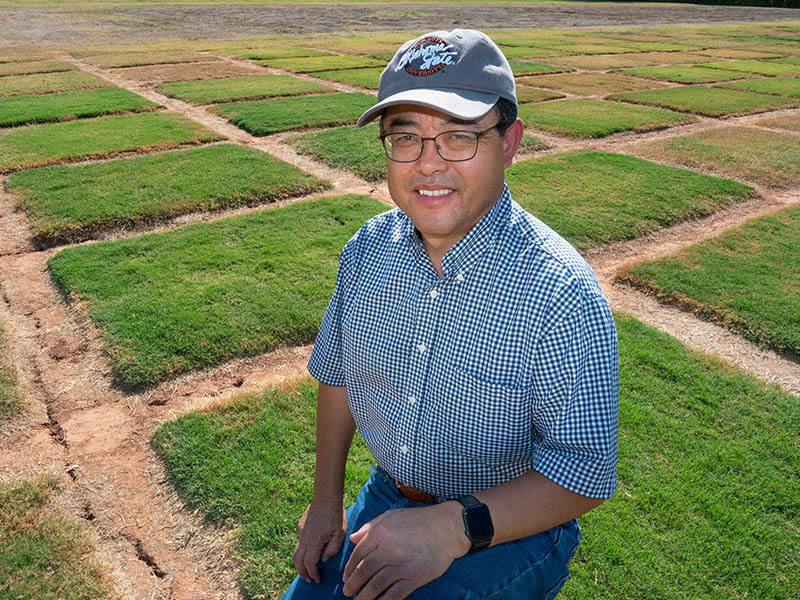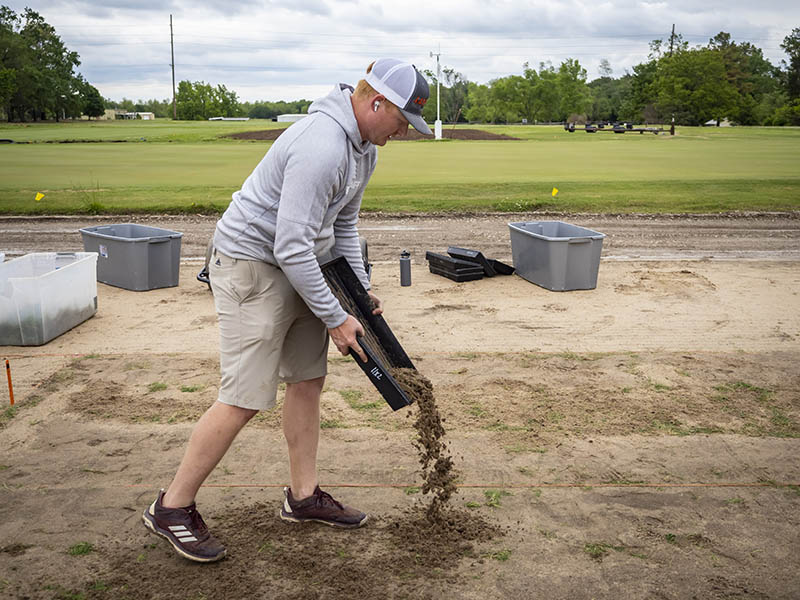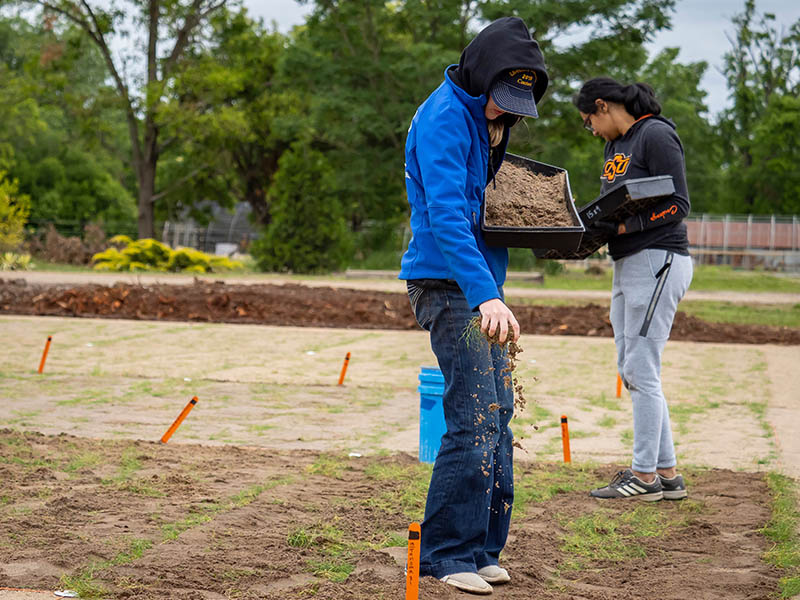
OSU announces two new turfgrass varieties
Thursday, May 19, 2022
Media Contact: Alisa Boswell-Gore | Agricultural Communications Services | 405-744-7115 | alisa.gore@okstate.edu
When golfers tee off at Southern Hills Country Club in Tulsa for the PGA Championship, who created the grass won't likely be top of mind. But for researchers at Oklahoma State University, the grass is their game.
Part of the turfgrass at Southern Hills Country Club was created at OSU and has become a staple at major sports venues around the world, such as major league soccer, baseball and football stadiums and Churchill Downs . Now, OSU scientists are excited to unveil two new varieties, which will be available for commercial use in the next two to four years.
OKC1876 and OKC3920 are crosses between common bermudagrass and African bermudagrass. According to Dr. Yanqi Wu, OSU plant and soil sciences professor and plant breeder, the two new varieties have unique genetic identities due to being crossbred from two different types of bermudagrass families.
OKC1876 and OKC3920 will become OSU’s ninth and 10th turf bermudagrass varieties to be released for commercial use since 1991. These new varieties were purpose built — like Tahoma 31, which is used in over 156 locations across the U.S. — for professional facilities like country clubs and municipal golf courses.
OSU scientists found that OKC1876 exhibits high turfgrass quality, improves drought resistance, retains excellent fall color, reduces seedheads and wide adaptation in southern states. It also demonstrates excellent establishment characteristics, fine texture, high turf density, dark green color, good traffic tolerance and sufficient sod tensile strength for reliable commercial production.
Turfgrass quality under drought stress data from the National Turfgrass Evaluation Program shows that OKC1876 was comparable to TifTuf — the national standard for drought resistance — and significantly better than Latitude 36.
“It is recommended for use on golf courses, lawns and other areas where high quality turfgrass is needed and good management can be practiced in the southern states,” Wu said of the OKC1876 cultivar.
OKC3920, targeted for use on putting greens, shows improved freeze tolerance that is significantly better than ultradwarf putting green bermudagrasses, and it demonstrates high turfgrass quality comparable to ultradwarf cultivars — the current industry standard for warm-season greens-type turfgrass.
The cultivar also shows sufficient establishment characteristics, fine texture, early spring green up (early growth in spring), dark green color and ball roll distance (the distance a golf ball can roll on it) approaching that of an ultradwarf bermudagrass. OKC3920 was tested at 19 locations in 15 states.
Because they have three sets of chromosomes instead of two or four sets, OKC3920 and OKC1876 reproduce vegetatively, or asexually. In the turfgrass industry, that’s a good thing.
“Sod producers can grow bermudagrass quickly and at relatively low cost, but they can grow OKC3920 even faster due to its reproductive capabilities,” Wu said, adding that producing in this way means that all OKC3920 bermudagrass is the same plant; therefore, it maintains its same high quality each time it is grown.
OKC3920 has improved cold hardiness and some disease resistance compared to top varieties. Its genetic color and leaf texture were comparable to or better than the three popular commercial varieties — TifEagle, Tifdwarf and Mini Verde. Its density was comparable to the three commercial varieties in some states and better in others, and there was no significant damage caused to the plant by disease pathogens, insects or nematodes.
“This grass is a scientific breakthrough because in the industry right now, concerning putting green bermudagrasses, we only have ultradwarf types, and ultradwarfs do not have cold hardiness. OKC3920 has proven resistant to winterkill,” Wu said. “That is why this grass stands out so strongly. Winterhardiness has traditionally been a signature of our OSU turfgrass development program.”
Traditionally, OSU turf bermudagrass releases have shown improved cold hardiness with each new variety. However, the focus of breeding behind OKC1876 was for improved drought resistance and fall color retention for southern states.
Many steps still need to happen before OKC1876 and OKC3920 can be released on the sod market. The next step is achieving licensing with sod producers to distribute the product, a process that has already begun, said Wu. The expected initial market availability for the two varieties is in the 2023 growing season, with widespread availability expected around 2025.
Other researchers involved in the development of these new turfgrass varieties include:
- Dennis L. Martin, professor of horticulture and OSU Extension specialist for turfgrass science
- Justin Quetone Moss, professor and department head of horticulture and landscape architecture and OSU Extension specialist for turfgrass science
- Charles Fontanier, associate professor of turfgrass science
- Nathan Walker, professor of entomology and OSU Extension specialist for turf disease and pest diagnosis
“This is a team effort,” Wu said. “When these people are all put together, they have a much larger pool of skill sets to be able to build a new product. Without each individual on this team, we would not have the ability to put out these strong turfgrass varieties.”
Tahoma 31 bermudagrass was the last OSU turfgrass variety to be released in 2017. It is still thriving in the market today. Yukon, Patriot, Latitude 36 and NorthBridge are other OSU turf bermudagrass varieties also available for commercial use. Midlawn, Midfield and Riviera are former commercial varieties developed by OSU.
“We are proud of our turfgrass team at OSU. The impact, value and reach that the varieties have had from Dr. Wu’s program have been staggering,” said Scott Senseman, associate vice president of ag research. “The commitment to enhancing turfgrass performance through research has never been more on display than through the releases of these two new varieties.”
Wu also talked about OSU's turfgrass research and the new varieties on the SUNUP TV show.
Creating new turf










